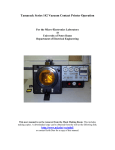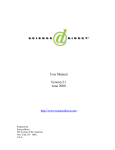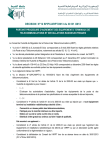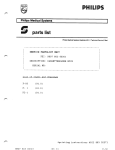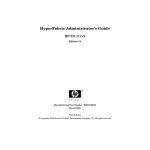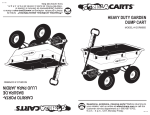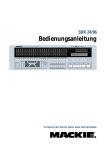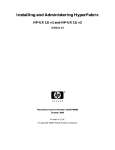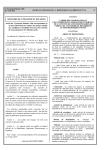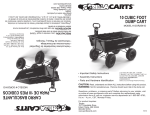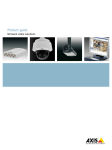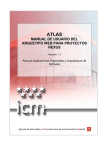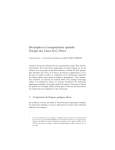Download Emulsion Plate Creation Using the Mann 3000
Transcript
Emulsion Plate Creation Using the Mann 3000 For the Micro-Electronics Laboratory At University of Notre Dame Department of Electrical Engineering This user manual is not be removed from the Mask Making Room. This includes making copies. A downloaded copy can be obtained from the web at the following link: http://www.nd.edu/~ee/ndnf/ or contact Keith Darr for a copy of this manual. Purpose The Mann 3000 is a computer controlled lithographic pattern generator used to generate master emulsion plates. These patterned emulsion plates are used to create photomasks for use in the photolithography for integrated circuits. Reference Documents Procedural documents written by Tatyana Orlova Additional Equipment Required None Materials Required Emulsion coated plate 5” X 5” (127 X 127 mm) PD-86 Photomask Negative Developer PF-95 Photomask Fixer 3.5” Floppy disk 100 Mega byte Zip disk Protective Equipment Required Safety glasses Latex Gloves Engineering and/or Administrative Controls Only authorized users may operate this piece of equipment Training To obtain training on this machine, please contact Keith Darr (office 221 Cushing, phone 1-5497, email [email protected]) Problems For problems, clarification of procedures, or general information pertaining to this machine please contact one of the following personnel. Keith Darr 631-5497 [email protected] Mike Thomas 631-7493 [email protected] Mark Richmond 631-6478 [email protected] In Case of Emergency, Please Contact Notre Dame Security at 911 MSDS’s can be located in the EE Department office or in Room 244 near the door. Keith S. Darr Rev 2.1 11/3/2008 2 Table of Contents Page 4-5 6 7 - 12 12 12 13-15 Keith S. Darr Rev 2.1 11/3/2008 Contents Authorized Users Setup Operation Developing Completing Operations Appendix 3 Authorized Users List Name Jie Wu Zach Gagnon Diana Hou Jeffery Bean Kai Sun Di Liang Wei He Lili Ji Yong Tang Niti Goel Ying Cao Ning Su Jon Valenzuela Qing Liu Ni Man Zhuowen Sun Jie Su Zengiao Jin Sangeetha Swaminathan Jon Baeten Bo Gao Jing Zhou Mike Coogan Chuanxin Lian Vlad Protasenleo David Deen Wentao Luo Adams Tong Siddharth Maheshwari Qinxin Zhang Juan Jiang Aaron Prager Heng Yang Loukas Tsagalas Chris Seibert Tom Zimmerman Jia Guo Keith S. Darr Rev 2.1 11/3/2008 Email [email protected] [email protected] [email protected] [email protected] [email protected] [email protected] [email protected] [email protected] [email protected] [email protected] [email protected] [email protected] [email protected] [email protected] [email protected] [email protected] [email protected] [email protected] [email protected] [email protected] [email protected] [email protected] [email protected] [email protected] [email protected] [email protected] [email protected] [email protected] [email protected] [email protected] [email protected] [email protected] [email protected] [email protected] [email protected] [email protected] [email protected] Advisor Chang Chang Chang Porod Merz Hall Lieberman Porod Fay Jena Hall Fay Xing Bernstein Fay Fay Bernstein Snider Wu Wu Lieberman Xing Chang Xing Ken Kuno Xing Chang Snider Chang McGiun A.E. Miller Snider Bernstein D.A. Hill Hall Xing Liu Date 04/29/04 05/27/04 05/27/04 06/3/04 07/26/04 07/26/04 10/05/04 10/08/04 10/08/04 10/22/04 12/14/04 12/20/04 02/23/05 03/16/05 02/28/05 04/11/05 04/14/05 04/18/05 06/15/05 06/15/05 06/17/05 07/19/05 08/12/05 9/16/05 9/9/05 10/18/05 10/24/05 10/24/05 10/25/05 10/25/05 10/25/05 10/25/05 4/18/06 06/08/06 8/14/06 12/11/06 12/21/06 4 Authorized Users List Name Peter Hoffman Zhen Wang Paul Robbins Preshant Deshlahra Kejia Wang Jason Kulick Yu Cao Gilad Yossifon Xinguong Cheng Sagnik Basuray Nishant Chetwani Dane Wheeler Nan Sun Chao Sun Ireneusz Janik Marya Lieberman Amol Singh Lisa Cole Xiu Xing Joe Bonath Kristen Anderson Andy Carter Connor Griffith Hubert George Yu-chen Chang Prasad Sarangapasei Yunshan Wang Dan Ho Qingling Hang Qin Zhang Keith S. Darr Rev 2.1 11/3/2008 Email [email protected] [email protected] [email protected] [email protected] [email protected] [email protected] [email protected] [email protected] [email protected] [email protected] [email protected] [email protected] [email protected] [email protected] [email protected] [email protected] [email protected] [email protected] [email protected] [email protected] [email protected] [email protected] [email protected] [email protected] [email protected] [email protected] [email protected] [email protected] [email protected] [email protected] Advisor Zhu Bohn Berstein Bernstein Jena Bernstein Jena Chang Chang Chang Chang Seibaugh Ruggiero Jena Ian Lieberman Jena Roeder Fay Bernstien Bernstien Bernstein Porod Snider Chang Zhu Chang Xhu Jena Seabaugh Date 3/22/07 4/11/07 6/25/07 6/25/07 07/17/07 08/17/07 09/05/07 10/08/07 10/08/07 10/08/07 10/08/07 10/23/07 12/19/07 4/14/08 04/30/08 05/14/08 05/21/08 06/18/08 06/18/08 06/23/08 06/23/08 06/31/08 07/01/08 07/16/08 07/25/08 08/21/08 07/25/08 09/12/08 10/07/08 10/29/08 5 Setup Note: Prior to mask creation, a plastic mask case for storing the reticle may be obtained from the lab staff. 1. Turn on the red light outside of the reticle room to indicate that the room is in use. 2. Set up the mask developing chemicals: a. The baths, which are located on the wet bench, are used to immerse the mask during the developing process. The solution contents are clearly labeled on each container lid. Be certain to not interchange the lids. Doing so will cause cross contamination of the solutions. b. Each developing bath should have a solution level of approximately ½” (1.25 cm) c. If the solutions in the baths are older than 3 days, they should be discarded and replaced with clean, fresh chemicals i. Empty developing baths in the wet bench sink. 1. Clean, fresh chemicals are in the lower right hand side of the reticle room wet bench. a. If this supply is empty, a new bottle may be obtained from the yellow chemical cabinet near the reticle room door. b. The bottles are dated. Use oldest dated bottle. Empty bottles or bottles dated greater than one year are to be discarded as per the laboratory safety manual. Note: The janitor will not empty the trash container located inside of the reticle room. If the trash is full, it is the responsibility of the lab user to exchange the container with the container located outside of the reticle room. ii. Replenish each bath at level of approximately 1/2” (1.25 cm) iii. In the logbook, record the exchange of solution. 3. Retrieve a box of emulsion plates from the yellow cabinet and place it on the table located in the printing room. a. The supply of emulsion plates is located on the left hand side of the cabinet. These containers are dated, use the oldest dated container. This one will likely have the tape removed from around the lid. \ Keith S. Darr Rev 2.1 11/3/2008 6 Operation 1. If the Mann 3000 PC is off, turn on the power to the PC a. The system will automatically boot into the pattern generator software 2. If the Mann 3000 PC is ON and at the DOS prompt a. Type PGEN and press Enter 3. If the emulsion plate is to be used to create a Stepper Mask (GCA 6300) a. Measure the plate dimensions and calculate the error as the difference between the measured dimensions and an ideal plate which would be 127mm. b. Take 2.5mm – (error/2) = offset c. Manually adjust the y-coordinate of the stage to offset before powering on the stage drivers. 4. If the emulsion plate is to be used to create a Contact Printer Mask (Karl Suss) a. Ensure that the y-coordinate of the stage is at 0.0 mm before powering on the stage drivers. 4. The Mann 3000 software will prompt the operator with the steps of operation. a. The first prompt is : “Enable main power and XYWHA chassis power ONLY!! Manually move X-Y staging to the ORIGIN position Press any key when done” i. The main power is the switch hidden directly below the shelf that the computer monitor and the keyboard sits. This switch should be on already, if it isn’t, turn it on. (Figure 2) ii. The stage should be at (0, 0) or (0, 2.5) depending on your process, however, you should verify its position. If it is not, then manually position the stage by rotating the stage position dials. (Figure 1) 1. The stage position is read on the linear gauges mounted on the right hand side of the stage. 2. Fine positioning increments are read on the micrometer dials. iii. The XYWHA chassis power is the right most switch on the XYWHA chassis. Turn this switch on only. Note: Do not turn on the X, Y, W, H and A switches at this time. (Figure 2) iv. Once these steps are complete, press “any key.” 1. Do Not use the Arrow Keys, this will cause an error. Keith S. Darr Rev 2.1 11/3/2008 7 b. On the right side of the software screen, ensure that all current positions, destinations, and velocities read 0. If there is any number other than 0 in this step, then the fuse is bad. i. Turn off the chassis power and replace the fuse. Reboot the computer using Cntl+Alt+Del. Restart the procedures. c. The second prompt instructs the operator to: “Enable each X, Y, W, H, and A motor Enable the flash unit Press any key when done” i. Switch the X, Y, H, W and A switches to the up position. ii. The power switch for the flash unit is the right most switch. This is a two-position switch. Make sure to position it completely up. The light will turn on. Note: Verify that the switch on the left hand side (AUTO/ MANUAL) is in the auto position. iii. Once these steps are complete, press “any key” 1. Do not use the Arrow Keys. This will cause an error. 2. The machine will automatically move the stage to the load position a. If you set the origin to be (0,2.5) the stage will move to (100, 102.5) b. There will be a small error at the load position, this is normal. The machine will work correctly and will create an accurate emulsion plate Note: If the stage reaches a limit condition, one of two red lights on the left side the stage will be illuminated. Contact lab staff. Note: Do not attempt to move the stages manually, by turning the stage micrometers, from this point on. Doing so, may cause damage to the equipment. 3. The help menu will appear on the screen a. The help menu contains a list of the commands available for use in the Mann3000 program. It is able to be redisplayed by pressing “H.” Keith S. Darr Rev 2.1 11/3/2008 8 5. Press the letter “O” to move the stage from the load position to the origin. Once this movement has completed, press “L” to return the stage to the load position. Perform this cycle 3 to 5 times. a. This will cause the lubricant on the Mann 3000 to spread evenly. i. Verify that the stage is moving to the correct position. 1. On the right hand side of the computer screen is a readout of the destination (xdes or ydes) and current (xcur or ycur) position. 2. If there is an error where the stage does not move to the correct location: for example, the reading on the computer indicates the stage is at (0,0) and the stage is actually at (50,0), or if a limit light is turned on, contact lab staff. The fuse is likely bad. Power down the system, change the fuse, and restart the procedure if trained. b. Finish the cycle with the stage in the load position. 6. Insert your 3.5” disk into the floppy drive a. If you are uncertain of your file name: i. Type “S” to cause the program to shell to DOS. 1. Press “Y” to continue ii. Type “a:” and press “Enter.” iii. Type “dir” and press “Enter” to display a directory of the A: drive. iv. Record the name of the file that you desire to use. v. Type “exit” and press “Enter” to return to the Mann 3000 program. b. If you know the name of your file: i. Type “F” ii. When Filename: appears, type the path and the name of your file with the “.dwm” extension 1. Make sure you specify a: 2. For example: Filename: a:test.dwm iii. Press “Enter” 1. At the bottom of the PC screen the Mann 3000 program will return “Data file : your file name” to indicate that the file has been loaded. 7. Press “E” a. This will verify the file syntax, report potential errors, and indicate the number of exposure counts. i. If there is a number of syntax errors, the disc may be bad or you may need to redo the file conversion process. Keith S. Darr Rev 2.1 11/3/2008 9 8. If you are making an emulsion plate for use on the GCA-3696 (contact mask) (stepper masks do not require this step): a. Type “<CTRL>-F” i. Hold the control button and type F. b. At the prompt “Fiducial Type [A,B,C]:” Type “A” i. This will cause the Mann 3000 to print the necessary alignment marks on the emulsion plate for alignment on the GCA-3696. 9. If a title is desired a. Press “T” i. Select Left ii. Choose 2.02 mm high iii. Include 1mm offset 10. Turn off all lights in the mask making rooms, except for the red lights. 11. Retrieve the plate holder from the cabinet that is to the left of the door. 12. Rotate the lock, on the back of the plate holder, counterclockwise to allow removal of the back of the plate holder. a. Load the emulsion plate into the plate holder with the emulsion side face down. The emulsion will be facing up when mounted when the plate holder is mounted on the Mann3000’s stage. Note: The emulsion plate’s box has a sticker on the front lower part to indicate the side of the plates that have the emulsion chemical. Handle the emulsion plate by the edges. Make sure not to touch the emulsion plate face, as this will cause defects on the emulsion plate. i. There are three small dots on the inside of the plate holder, two on one side, and one on another. (Figure 5) Pick the plate holder up and slightly tilt it so that the emulsion plate is aligned against the two dotted sides of the plate holder. Keith S. Darr Rev 2.1 11/3/2008 10 13. Reinstall the back of the plate holder. Make sure the plate stays aligned. a. Apply a slight amount of pressure downward and lock the back of the plate holder in place. The plate holder back has spring-loaded pins that will apply pressure to the plate when installed. b. The lock should be perpendicular to the frame if properly locked. c. Turn the plate holder over so the emulsion plate is face up and bring it over to the Mann 3000. d. While the holding the fasteners lifted up slightly, carefully slide the plate holder into position on the stage under the optical column. i. Do not let the fasteners drop while positioning the plate holder. Doing so may cause damage to the level stage surface. e. Align the plate holder to the stage alignment pins as per the following steps: Note: There are two pins mounted on the rear of the stage. (Figure 4) On the edge of the plate holder, there are two alignment plates. One of the alignment plates is flat and the other has an "L" shape if viewed from the top of the plate holder down. (Figure 5) f. Slide the plate holder in place so that the "L" plate is against its associated stage pin. It should be touching the pin both on its flat side and on its extended side. (Figure 6) g. Using the "L" side's stage pin as a pivot point, slightly rotate the plate holder until the flat alignment plate is against the its associated stage pin. (Figure 7) h. The stage pins will be touching the plate holder alignment plates at 3 points if the plate holder is correctly aligned; 2 points on the "L" plate and 1 on the flat plate. 14. While holding pressure on the plate holder and maintaining the correct alignment position, tighten down the fasteners, finger tight, to attach the plate holder correctly to the Mann 3000 stage. (Figure 8) 15. The plate it ready for printing. Type P. a. If you choose, you may type I instead of P to produce a mirror image pattern. Doing so will rotate the image about the y-axis 180 degrees. b. The Mann 3000 will begin printing the emulsion plate. c. When the exposure process is complete, the stage will move to the load position and the computer will display a message indicating completion of the exposure. 16. Remove the plate holder by loosing the retaining screws and sliding it out in a similar fashion as it was inserted. Be certain to lift the fasteners up slightly so to prevent them from catching on the stage. a. Be careful to not hit the emulsion plate on the column extending down or you may cause a scratch on the objectives. Keith S. Darr Rev 2.1 11/3/2008 11 17. Bring the plate holder over to the table and turn it over so that the emulsion plate is facing down. Rotate the lock on the back of the plate holder to unlock the plate holder back. Carefully remove the emulsion plate from the plate holder. a. The side facing up does not have any emulsion on it and will not scratch if touched slightly. However, try to only touch the outer edge of the emulsion plate to minimize the number of particles generated on the plate. b. Replace the back of the plate holder and lock it in place. 18. Bring your plate to the front room to be developed. Developing Note: Slightly agitate the bath solutions during the developing process to ensure a constant concentration of the solution. Use Teflon tweezers to remove the plate from the developer solution. 1. 2. 3. 4. 5. 6. Use PD-86 developer to develop the emulsion plate for 5 min. Rinse the plate in DI water for 1 min. Put the plate in fixer PF-95 for 3 min. Rinse the plate in DI water for 1 min. Rinse the plate with Methanol. Place the plate in the slotted Teflon plate holder and let air dry a. Alternatively, you may blow dry the plate with Nitrogen. Completing Operations 1. The lights may be changed back to the yellow lights at this point. 2. On the computer Type “O” to cause the Mann 3000 to move to the origin position. This will position the stage for the next user. 3. Turn off the flash lamp power supply. 4. Disable the X, Y, H, W and A motors and turn off the chassis power for this unit. 5. Exit the Pgen3001 software by pressing “X.” 6. Return the emulsion plate box to the yellow cabinet by the front room door. 7. Clean up the work space 8. Indicate the number of emulsion plates that were used, chemicals changed, or any other important information in the logbook and log out. 9. If you are finished with the reticle room, turn off the outside red light. Keith S. Darr Rev 2.1 11/3/2008 12 Appendix System Power Figure 1 Manually setting stage position Stage power is the switch on the right Figure 2 Figure 3 Keith S. Darr Rev 2.1 11/3/2008 System power and Stage control Flash Lamp Power Supply Power switch is right most 13 Figure 4 Stage alignment pins Figure 5 Alignment points for the emulsion plate Figure 7 Aligning the plate holder Keith S. Darr Rev 2.1 11/3/2008 Figure 6 Aligning the plate holder Figure 8 Tightening the plate holder to the stage 14














